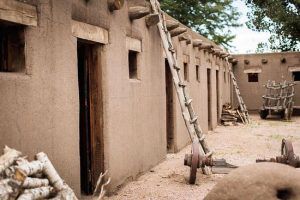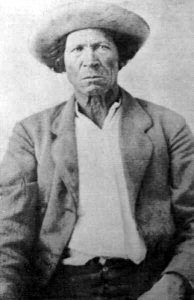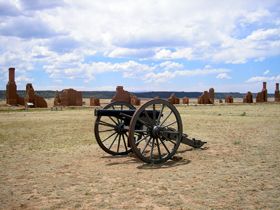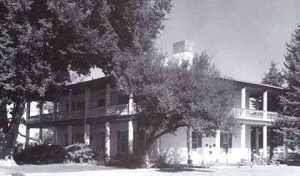In November 1847, settlers living in and around El Pueblo, Colorado, heard that Mexico City had fallen to the Americans, and the Mexican-American War was over. Late that same month, trader Alexander Barclay, a trader who had helped to establish El Pueblo and Hardscrabble in Colorado, sold out his property.
In March 1848, Alexander Barclay, along with trader George S. Simpson traveled down the Mora River from Colorado to Watrous, New Mexico. Thomas Fitzpatrick, a well-known fur trader, had previously told Barclay and another trader, named Joseph Doyle that the US Government would probably build a fort in the area to protect travelers on the Santa Fe Trail from marauding Indians.
Barclay and Doyle’s plan was to build a fort here and then sell it to the government for a profit. It was also a great location for a trading post for Santa Fe travelers because it was located near the point where the Cimarron Cutoff and the Mountain Branch of the Santa Fe Trail merged. After seeing the property, Barclay quickly went to Santa Fe and bought a portion of the Scolly Land Grant.
On April 23, 1848, the largest caravan ever to cross the Raton Pass left Pueblo, Colorado, and headed south. With 18 armed men, the heavily loaded wagons, filled with household goods, food, and supplies, they made progress at a rate of about 7-10 miles per day and arrived at the foot of Raton Pass on May 1st. After leaving the women and children in Mora, New Mexico, the men arrived at the La Junta Valley and immediately began the work of establishing a “fort.” Here, supplies were easier to obtain than in Colorado as whiskey, flour, and other supplies came from nearby Mora and Taos, New Mexico.
Soon after, Charles Autobees came from Mora, New Mexico, to supervise the construction of the adobe Fort Barclay. Before long, two irrigation ditches had been dug to water the 200 acres, built a fortified wall, constructed a number of cabins, a blacksmith shop, a water well in the center, and corrals. The fort cost $28,000 to build. By September 4th, the fort was sufficiently finished that Barclay brought his wife, Teresita Suaso, to her new home. On September 19th, Joseph Doyle arrived with a blacksmith, and a few days later, he brought his own wife down from Mora.
Sitting on an acre of land, the large, square enclosure, with 16-foot adobe walls, two circular bastions each with a six-pounder gun, and a heavy gate that could be locked, was used as a camping place for pioneers and wagon trains. Called Barclay’s Fort, it quickly became a very popular stopping point along the Santa Fe Trail. The fort bustled with trading activity daily, served as a stagecoach station, provided housing for men, shelter for animals, a camping place for wagon trains, and its stockade furnished protection from Indian raids. At some point, a post office opened.
“Constant excitement and daring adventure… the reckless activity and thrilling interest of a border life… and the pursuit of free will, free trade, and free-thinking” — Alexander Barclay
In 1850, Barclay tried to sell his fort to the Army for $15,000, but they wouldn’t buy it. Instead, Lieutenant Colonel Edwin V. Sumner tried to order him off his own land so the Army could build their own fort there. In 1851, Sumner began the work of establishing Fort Union about nine miles northwest of Watrous. Located near Alexander Barclay’s land, the Army again tried to order him off his own land, but Barclay took the army to court, which dragged on for several years.
After the construction of Fort Union, the future of Barclay’s Fort was dim as the prices of beaver pelts and buffalo hides had dropped. In letters to his brother, Barclay outlined the hopelessness of his financial situation – his $5,000 debt, the constant depletion of his cattle herd through Indian depredation, and the huge cost of feeding his household and help.
In 1853, Barclay made a trip north to trade with the Indians and found they’d moved from where he thought they were. He suffered a large financial loss. When he returned to the fort, he found that operations were out of control and the fort in bad repair. By the end of October, he was living at the fort by himself. He and Doyle advertised the fort for sale in the Santa Fe newspapers but never had an inquiry.
In November 1853, New Mexico’s attorney general, W. W. H. Davis, would describe the post:
“It is a large adobe establishment, and, like the immense caravansaries of the East, serves as an abode for men and animals. From the outside, it presents a rather formidable as well as neat appearance, being pierced with loop holes and ornamented with battlements. The rooms within were damp and uncomfortable, and all the surroundings looked so gloomy, the hour being twilight, that it reminded me of some old state prison where the good and great of former times have languished away their lives.”
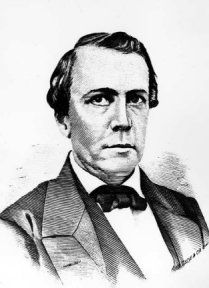
Joseph Doyle, Colorado trader
In 1854, the post office at Fort Barkley closed, and it would be over a decade before another would open in nearby Watrous. Alexander soon grew very ill and died at the age of 45. He was buried at his “fort” in December 1855.
Litigation with the army over the land dispute continued with Joseph Doyle, who finally won out. In 1856, Doyle sold the land and the fort to a German immigrant named William Kronig for about $7,000. Kroenig soon collected 94 head of cattle and 200 sheep, which he drove to Watrous. He cemented a familial relationship with Samuel Watrous by marrying his daughter, Louisa. He lived at Barclays Fort until he built his showpiece Phoenix Ranch in 1862 just west of his father-in-law’s. Here, he created nine artificial lakes and stocked them with fish.
The remains of Barclay’s fort were destroyed by a spring flood in about 1900. Kroenig’s Phoenix Ranch, which still exists today, is all that is left of Barclay’s previous holdings.
Barclay’s Fort was located about two miles north of Watrous on the south bank of the Mora River, west of 1-25. Though the buildings are long gone, the foundations can still be seen in the historic district.
© Kathy Weiser/Legends of America, updated August 2021.
Also See:
Alexander Barclay – British Trader on the Santa Fe Trail

